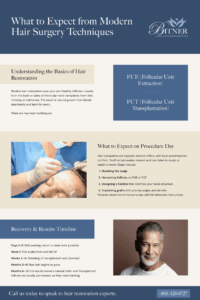Hair loss doesn’t just affect appearance. It can impact confidence, self-esteem, and even social engagement. Fortunately, advances in hair surgery have made it possible to restore a fuller, natural-looking hairline without the stigma or scarring once associated with transplants. Today’s procedures are minimally invasive, highly effective, and customized to each patient’s unique hair pattern and goals.
If you’re researching men hair transplant options or wondering what modern hair restoration actually involves, here’s what you can expect before, during, and after surgery.
Understanding the Basics of Hair Restoration
Modern hair restoration techniques use your own hair—usually from the back or sides of the scalp—and relocate those healthy follicles to areas experiencing thinning or baldness. This process creates natural-looking growth that continues for years.
Most procedures fall into one of two main categories:
- FUE (Follicular Unit Extraction): Individual follicles are removed and placed in balding areas. This leaves no linear scar and requires minimal recovery downtime.
- FUT (Follicular Unit Transplantation): A thin strip of scalp is removed, and follicular units are harvested and implanted. This may be ideal for patients needing large graft counts.
Day of the Procedure: What Happens?
If you’re scheduled for hair surgery, expect a comfortable, in-office experience that lasts several hours. The procedure typically includes:
- Local anesthesia to ensure the scalp is completely numb
- Precision harvesting of follicles (FUE or FUT)
- Careful design of the new hairline based on facial structure and existing hair growth
- Implantation of grafts with attention to angle and density
Most patients are awake during the process and can listen to music or even watch a movie. Aftercare instructions are given before you leave, and patients typically return home the same day.
Recovery Timeline and Results
Modern hair transplant recovery is much easier than many people expect. Here’s a quick overview of what to expect post-procedure:
- Days 1–3: Mild swelling and soreness; patients can usually return to non-strenuous work.
- Week 1: Tiny scabs form around transplanted follicles and fall off naturally.
- Weeks 2–4: Transplanted hairs often shed—this is normal.
- Months 3–6: New hairs begin to grow in gradually.
- Months 6–12: Final results appear, revealing fuller hair volume and natural texture.
Results are long-lasting and often permanent, since the transplanted follicles are genetically resistant to balding.
What Causes Male Pattern Baldness?
The most common form of hair loss in men is male hair baldness pattern, also known as androgenetic alopecia (AGA). It’s hereditary and can begin as early as your 20s.
According to the Cleveland Clinic, “Half of the men in the world experience hair loss by age 50. About 70% of men will lose hair as they get older. And 25% of bald men see first signs of hair loss before age 21.”
Dermatologist Dr. Amy Kassouf explains that “recent advances offer a lot of hope in both treating and preventing different types of baldness,” but also cautions that research is still ongoing and many experimental treatments are not yet available to the public.
How Much Does a Hair Transplant Cost?
Cost is one of the most common concerns for patients considering a hair procedure. So how much does it cost for hair transplant surgery?
The hair transplant price depends on several factors, including:
- The number of grafts needed
- The method used (FUE vs. FUT)
- The complexity of the hairline design
- Whether multiple sessions are recommended
If you’re researching hair implants cost or wondering how much does hair transplant cost in Utah, know that most procedures range from $4,000 to $12,000. A personalized consultation will provide an exact quote based on your needs.
Are You a Good Candidate?
You might be a strong candidate for hair restoration if:
- You have sufficient donor hair at the back or sides of your scalp
- You’ve been experiencing stable hair loss for at least a year
- You’re in good general health
- You have realistic expectations about results
The best candidates have clearly defined bald or thinning areas with enough remaining hair to support grafting. Early consultations can also identify if non-surgical options (like PRP or medication) might be beneficial in combination with surgery.
Why Choose Utah Hair Restoration?
Utah Hair Restoration combines advanced surgical techniques with personalized patient care. Dr. Thompson and his team have decades of experience performing precise, natural-looking transplants. Patients across the state trust the practice not just for its technical skill, but for its compassionate approach that treats each patient’s goals as unique.
Whether you’re in the early stages of hair thinning or looking to restore significant loss, their team will walk you through every step—from consultation to recovery—with honesty and expertise.
Modern Hair Surgery Offers Real Results
Hair loss can feel discouraging, but today’s techniques offer real, lasting solutions. With modern hair surgery, patients can reclaim their hairline, their confidence, and their appearance with minimal discomfort and impressive results.
If you’ve been wondering how much does it cost for hair transplant or if you’re a candidate for men hair transplant, now is the time to get the answers you need.
Reach out to Dr. Bitner’s office today at (801) 525-8727 to schedule your consultation and learn how modern hair surgery can help you restore your hair—and your confidence.


